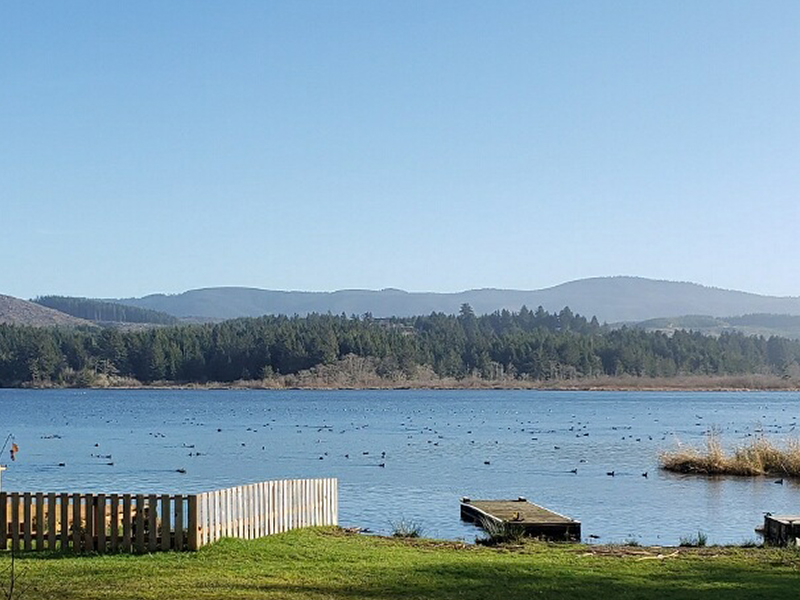
The Devils Lake Water Improvement District (DLWID) seeks to bring grass carp back to curb invasive water weed growth wreaking havoc in Devils Lake.
Devils Lake Neighborhood Association (DLNA) sent out an email asking people to send a letter to the Oregon Department of Fish and Wildlife (ODFW) in an effort to reintroduce sterile grass carp into Devils Lake to deal with the elodea invasive species.

DLWID and its board of directors have been working for the past few months to get the required permit from ODFW and is “nearing the finish line” according to the DLNA. In order for the permit to be processed, a change to Oregon’s Administrative Rules needs to be made.
From the DLNA:
We have been working extensively with ODFW staff to draft the required rule changes. Once finalized, these draft rule changes will be presented to the ODFW Commission in February with a recommendation from staff for approval. The District is optimistic that these rules will be approved leading to the successful placement of grass carp in late spring of 2023.
We have been assured that the ODFW Commission will place this issue on its agenda for their meeting held February 16th and 17th, 2023. Our attorney Sarah Stauffer-Curtiss from Stoel Rives will be making comments on behalf of the lake. We are not recommending that our public attend this meeting as we feel it will be more effective for the Commission to hear our support for the rule change via written submissions.
To assist DLNA and DLWID accomplish their goal of getting the carp into the lake to solve the elodea problem, a letter has been put together and the Devils Lake organizations are asking citizens to send it to ODFW Commissioners by Feb. 14.
Copy of the letter:
Dear commissioner:
Devils Lake is an integral part of my neighborhood and now more than ever our beautiful lake needs our help. The Devils Lake Water Improvement District (DLWID) is pursuing a permit under OAR 635-056-0075(2) from the Oregon Department of Fish and Wildlife (ODFW) to re-introduce sterile grass carp into Devils Lake. In furtherance of this goal the District has submitted a permit application which also serves as its management plan setting forth the timelines, policies, and processes that will be used for the re-introduction and ongoing management of grass carp in Devils Lake. In order for our permit to be processed certain changes to the Oregon Administrative Rules (OAR’s) will be presented by ODFW staff for your consideration in the February Commission meeting.
I would like to express my sincere appreciation toward the ODFW staff for working through these issues and identifying the OAR changes that are currently before you for consideration. I would also like to thank you in advance for the pending approval of the required rule changes. A positive response by the Commission will allow the Devils Lake Water Improvement District to begin stocking sterile grass carp this spring.
The stakes couldn’t be higher as over the past year, the situation in Devils Lake has become dire with the explosive growth of elodea. In 2019, DLWID conducted a plant survey which was used to map plant biomass in the lake. At that time, elodea was discovered in a limited area immediately adjacent to Devils Lake State Park boat ramp. In August 2022, the Devils Lake Neighborhood Association performed an extensive survey of the lake indicating 48.6 percent of the lake by volume was occupied with elodea. Surface coverage of the weeds was 40.1 percent, with 100 percent of the bottom of the lake covered with elodea. Engineering estimates of the volume of material indicate as much as 116 million cubic feet of elodea present at the time of the survey.
Given the shallowness of the lake, elodea is greatly impacting all beneficial uses of Devils Lake, including the migration of native coho salmon into Rock Creek. Native freshwater clam beds have disappeared in some areas of the lake, impacting otters. Limited visibility is impacting the use of Devils Lake as a nesting and feeding ground for bald eagle, osprey, egrets, herons and migratory birds. Many areas of the lake have become unnavigable to boats and unsafe for swimming. Continuing to allow the explosive growth of elodea into Devils Lake may result in the introduction of this invasive species into other water bodies throughout the Pacific Northwest through direct transmittal on watercraft. Although the Devils Lake Water Improvement District is committed to implementing a multi-pronged approach to addressing elodea, the introduction of grass carp into Devils Lake is vital to a long-term solution to this problem.
To ensure that Devils Lake Water Improvement District has the tools necessary to ensure the lake can be enjoyed by Oregonians for generations to come, I request that the Commission vote in favor of the proposed changes to OAR 635-056-0075(1)(a).
Sincerely,
John and Jane Smith
1234 NE My Street
Lincoln City, OR 97367
ODFW Commission Email: [email protected]







Years ago when the lake was poisoned with Rotenone to kill the trash fish–carp– it killed the fish that kept weed growth under control. Basically there were two strips of reeds and the lilly pads on shallow parts. Bringing in the sterile carp alleviated the problem of the milfoil that we had. Now I have a question –would the weed growth be slowed by clearing the mouth of the lake and allowing the water to flow faster? Maybe notbut the local people used to keep the lake and canals dredged and the former Anchorage kept the mouth area cleared!! Please don’t allow the lake to become a weed-filled mess!! Thank you!
I’ve done some handyman work at the condominiums there, and I got the impression that the city was preventing the clearing of the water flow to
the ocean. I can’t think of a single environmental disaster caused by
the introduction of non- native animals…